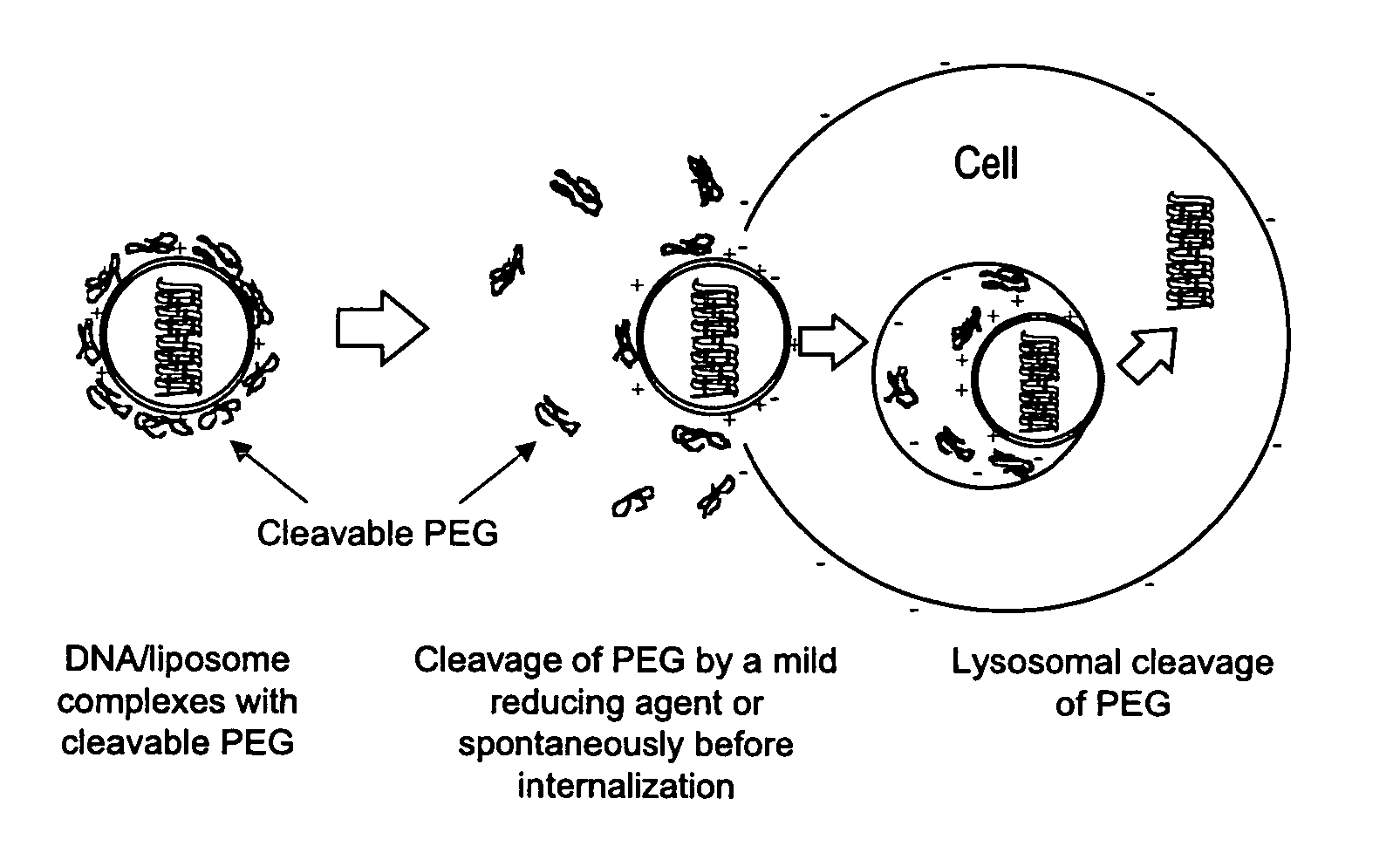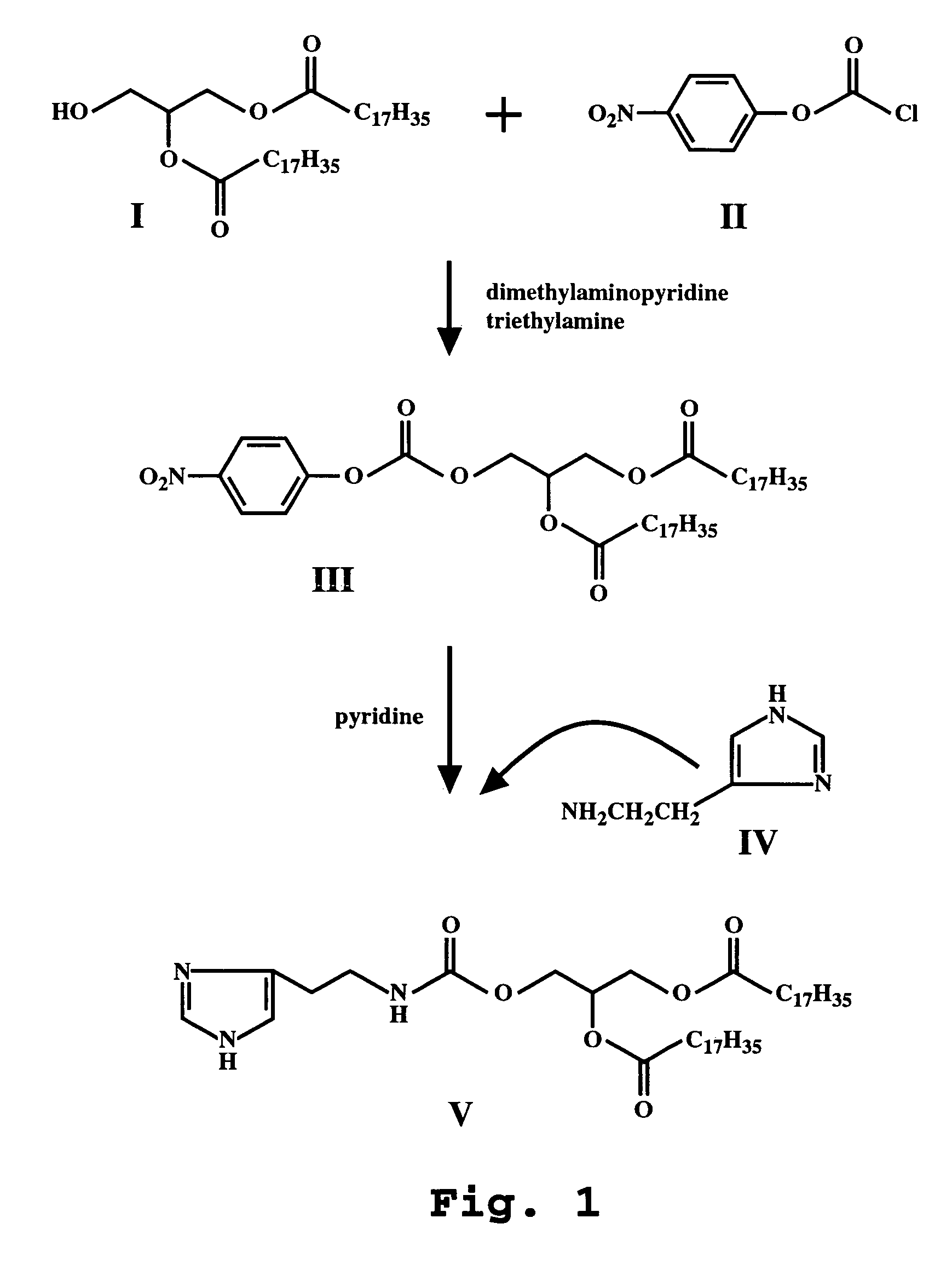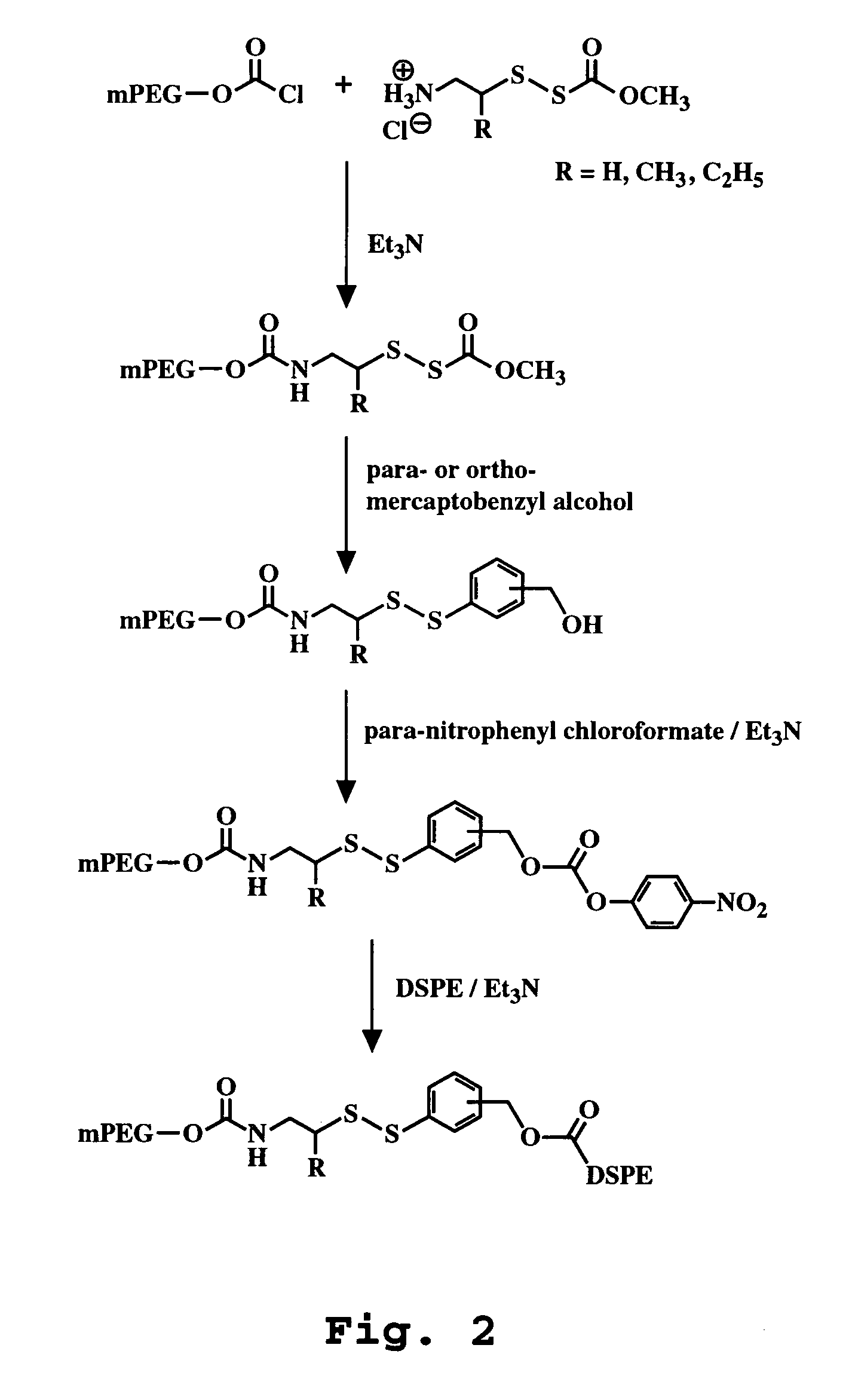Gene delivery mediated by liposome-DNA complex with cleavable peg surface modification
a technology of liposomes and dna complexes, applied in the direction of biocide, group 5/15 element organic compounds, genetic material ingredients, etc., can solve the problems of undesirable sites, easy entrapment of lung cells, and inability to deliver genes to systemic sites of diseas
- Summary
- Abstract
- Description
- Claims
- Application Information
AI Technical Summary
Benefits of technology
Problems solved by technology
Method used
Image
Examples
example 1
Synthesis of mPEG-DTB-DSPE
[0110]The reaction scheme is illustrated in FIG. 2.
[0111]mPEG-MeDTB-nitrophenylcarbonate (300 mg, 0.12 mmol, 1.29 eq) was dissolved in CHC13 (3 ml). DSPE (70 mg, 0.093 mol) and TEA (58.5 μl, 0.42 mmol, 4.5 eq) were added to PEG-solution, and was stirred at 50° C. (oil bath temp). After 15 minutes, TLC showed that the reaction didn't go to completion. Then two portions of TEA (10 μl, and 20 μl), and few portions of mPEG-MeDTB-nitrophenylcarbonate (50 mg, 30 mg, 10 mg) were added every after 10 minutes, until the reaction went to completion. Solvent was evaporated. Product mixture was dissolved in MeOH, and 1 g of C8 silica was added. Solvent was evaporated again. Product containing C8 silica was added on the top of the column, and was eluted with MeOH:H2O gradient (pressure), MeOH:H2O=30:70, 60 ml; MeOH:H2O=50:50, 60 ml; MeOH:H2O=70:30, 140 ml (starting material eluted); MeOH:H2O=75:25=40 ml; MeOH:H2O=80:20, 80 ml (product eluted); MeOH:H2O=85:15, 40 ml; MeO...
example 2
Synthesis of mPEG-DTB-DSPE
[0114]A. mPEG-MeDTB-DSPE
[0115]This reaction scheme is illustrated in FIGS. 4A-4B.
[0116]mPEG(5K)-OH (40 g, 8 mmol) was dried azeotropically with toluene (total volume was 270 ml, 250 ml was distilled off by Dean-Stark). Dichloromethane (100 ml) was added to mPEG-OH. P-nitrophenyl chloroformate (2.42 g, 12 mmol, 1.5 eq), and TEA (3.3 ml, 24 mmol, 3 eq) were added to PEG solution at 4° C. (ice water), while taking precautions against moisture. Light yellow TEA hydrochloride salt was formed. After 15 minutes cooling bath was removed, and the reaction mixture was stirred at room temperature overnight. TLC showed (CHC13:MeOH:H2O=90:18:2) that the reaction was complete. Solvent was evaporated. The residue was dissolved in ethyl acetate (˜50° C.). TEA hydrochloride salt was filtered off and washed with warm ethyl acetate. Solvent was evaporated and the product recrystallized with isopropanol (three times). Yield: 38.2 g (92%). 1H NMR (DMSO-d6, 360 MHz) δ 3.55 (s, P...
example 3
Synthesis of mPEG-DTB-nitrophenvichloroformate
[0127]This reaction scheme is illustrated in FIG. 5.
[0128]A. Procedures for Synthesis of 1-(mercaptomethyl)ethylammonium Chloride
[0129]1. 2-Amino-1-methylethyl hydrogen sulfate. 1-Amino-2-propanol (22.53 g, 0.3 mol) was vigorously stirred in an ice bath. Sulfuric acid (16.10 ml, 0.3 mol) was added very slowly, over the course of one hour. Thick vapors and a very viscous solution were formed in the flask. After addition was complete, the reaction was heated between 170° C. and 180° C., under reduced pressure, connected to the house vacuum. Upon heating, the reaction turned light brown. After all water was removed (approximately 1 hour) it was allowed to cool to room temperature. Upon cooling a brown, glassy solid was formed which would crystallize when triturated with methanol. It was dissolved in water (50 ml) at 60° C. Enough warm methanol was added to make the solution 80% methanol. Upon cooling, crystals formed which were then filtere...
PUM
| Property | Measurement | Unit |
|---|---|---|
| pH | aaaaa | aaaaa |
| MW | aaaaa | aaaaa |
| MW | aaaaa | aaaaa |
Abstract
Description
Claims
Application Information
 Login to View More
Login to View More - R&D
- Intellectual Property
- Life Sciences
- Materials
- Tech Scout
- Unparalleled Data Quality
- Higher Quality Content
- 60% Fewer Hallucinations
Browse by: Latest US Patents, China's latest patents, Technical Efficacy Thesaurus, Application Domain, Technology Topic, Popular Technical Reports.
© 2025 PatSnap. All rights reserved.Legal|Privacy policy|Modern Slavery Act Transparency Statement|Sitemap|About US| Contact US: help@patsnap.com



